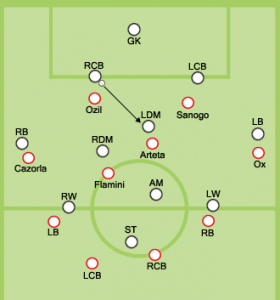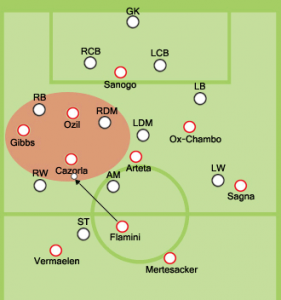There were many moments of individual – and collective – brilliance in Arsenal’s 4-1 FA Cup win over Everton, but it was the contributions of Arsenal’s two elder statesmen, Mikel Arteta and Tomas Rosicky, that stuck in the mind. Of course, Arteta was involved in the major flashpoint of match, finishing with aplomb a penalty which had to be retaken, highlighting his mental toughness. The other contribution was more subtle, Rosicky coming on for Alex Oxlade Chamberlain, whose skill won the penalty and who terrorised Everton’s defence with his pace, providing Arsenal with an finality to their play which perhaps was lacking.
The Gunners proceeded to then score the two goals that killed off the tie. As @GoonerDesi tweeted after the game, there is “more than one way to skin a cat”: Arsenal’s speed with the ball, rather than without it, made the difference between the two teams much larger than it seemed.
The reason why I highlight the contributions of these two players is because they give Arsenal something extra on the psychological front that they have lacked during the barren years without a trophy. Of course, Arsenal still rely heavily on having good days playing attractive football and that perception of superiority overwhelming teams, but Arteta and Rosicky, having suffered their share of setbacks in their careers, offer a mental resolve to Arsenal’s play too.
Remember, it was last season, and the season before that, that the pair were crucial in Arsenal’s good run of form to get them to the Champions League positions. The season before, in 2010/11, Arsene Wenger mentioned that is was a regret that he didn’t use Rosicky more, having got Arsenal into a position to challenge in all four competitions, but ignored him almost completely as Arsenal dramatically collapsed. In the post-Invincibles era, there was arguably too much pressure on the young stars and as such, letting them mature without the presence of big name players like Patrick Vieira and Thierry Henry left a bit of fragility in the team that often frustrated.
In their roles, Arteta and Rosicky are of the age where their maturity brings balance to the side, that extra know-how that is almost inexplicable but a valuable commodity nevertheless. Xabi Alonso expands on this an interview with France Football (thanks to @Chase_Ryan for the translation):
Q: What does maturity mean?
Xabi: “It’s knowing what to do at every moment of the game. When you’re not mature enough, you have plenty of energy, but you do things which aren’t what your team needs. Maturity is knowing how to manage your efforts. Take good decisions quickly.
“A midfielder like me needs to take a lot of little decision correctly. When you’re young, you can show you’re brilliant on one choice, but get it wrong on 3 others. For a striker being brilliant is scoring. In my position, it’s being reliable. Never make mistakes.
“Some have to be ‘unbalancing’. Me; I have to be ‘balancing’. This combination makes good teams.”
Xabi Alonso’s explanation helps underline why it is important not to rush too quickly to criticise Jack Wilshere. In last week’s Tactics Column I ask to what degree is Wilshere unlucky in terms of knowing where to go on the pitch or just making the wrong decision? In his role in front of the holding midfielder, it’s his responsibility to create clever angles to glue Arsenal’s passing game and in the defensive phase, block potential passing lanes whenever the opponent tries to build from the back. Wilshere’s constant pointing and cajoling of team-mates suggests he knows it’s about making little decisions correctly. The irony is whether he’s making the correct decisions himself. Of course, the only proof is the team playing well and as such, his performance in the 1-0 defeat to Stoke City was below-par.
Unfortunately, injury ruled Wilshere out of the FA Cup Quarter-Final against Everton, meaning Arsenal were understaffed in the “number 8” role that he plays. Instead, that forced Arsenal to play the Arteta-Flamini axis again, a pairing that in some of their matches playing together had seemed incompatible. Previously they’d assume a shared role: when one pushes forward the other stays back, in an attempt to find a compromise between the two players’ limitations going forward. It didn’t work however, with Flamini’s natural tendencies to drop back anyway repelling him from the opponent’s goal and Arteta, having adjusted his game to a more defensive one, seemingly unable to make the transition back to a more forward-thinking midfielder.
Against Everton, however, Wenger did away with the shared partnership and instead asked Arteta to play higher up to disrupt Everton’s passing. That decision was made in much part due to the way Everton dominated Arsenal in the league encounter in December and as Wenger’s go-to guy, Arteta had the tactical acumen to execute the game-plan. At times, pressing all the way up the pitch left Arsenal open but with Flamini patrolling the area in front of the defence with his high fitness levels, it was almost the perfect way to make use of the two midfielders.
Caught up in the cup fever, Arsenal’s energy was incessant from the off, snapping and snarling at the feet of Everton’s midfielders whenever they had the ball and when they won it back, broke with pace. Possession was sloppy sometimes as both teams were wary not to give an inch, but that also led to an open, end-to-end exchange. It seemed that both managers were happy with that as it was validation that their game-plan was knocking the other off their rhythm.
Arsenal hit first when Mesut Ozil opened the scoring although the goal highlighted the fine margins between desire and over-zealousness. Following a quick exchange between Santi Cazorla and Mathieu Flamini, Everton pressure nearly forced the ball over in Arsenal’s own half before playing the ball forward again. When Cazorla received the ball from Oxlade-Chamberlain, Everton’s James McCarthy came rushing in, his momentum taking him away from the ball allowing Cazorla to escape. That suddenly opened up space on the other side for Cazorla to slip the ball through to Ozil to score.
Everton’s equaliser came from an error in judgment of sorts too, with Arteta finally rising to the Arsenal fans’ demands to “SHOOOOT”. It was duly blocked and Everton broke leaving them exposed at the back. Flamini was unable to dive in to make a challenge as he was already booked and that allowed Ross Barkley to run the half the length of the pitch before crossing the ball for Romelu Lukaku to eventually finish.
There would be a couple more chances for Everton to score on the break, the first when Lukaku dallied on the ball allowing Oxlade-Chamberlain to get back and make a tackle and the second when Barkley skewed a shot over the crossbar. But for the most part, Arsenal were the more dominant side, passing the ball more swiftly by creating overloads and situations of 3v2s, and pressing higher up the pitch.

Arteta was crucial in setting the tone for Arsenal’s play, not only by completing the most passes in the game, his probing and prompting keeping Arsenal on the front foot, but also through his intelligence and anticipation.
Often he was the man stopping Everton passing the ball into the midfield, positioning himself tightly on Gareth Barry and James McCarthy. Indeed, this was a theme each Arsenal player took, each broadly given a man to mark and preventing Everton building the ball out from the back. Ozil and Sanogo marked the two centre-backs, forcing the game to be played through the wing-backs. Of course, that’s Everton’s main strength but the touchline effectively divides the playing field meaning the ball will eventually have to be played infield and that’s where Arsenal were most organised.
Going forward, there was great synergy between Arsenal’s attacking players who frequently interchanged positions to provide options on the ball to create the best situations to play their “zippy passing”. Santi Cazorla particularly took full advantage of the freedom Wenger caters for his players, and the extra space that Ozil, moving wide, or Sanogo occupying the centre-backs, created. It was this partnership in particular, between one of the creative wide players and Ozil, and then a full-back over-lapping, which proved highly productive. Indeed, it’s creating these situations which Arsenal frequently practises on the training ground, as Arteta explains to Four FourTwo Performance:
“At Arsenal, we do a lot of exercises where you have to play through the mannequins, but you can use cones. This is a great drill because it’s real; you’re moving and finding the holes to play the diagonal pass, just like in a match.
“The drill starts with player one passing the ball through two mannequins to player two, who with one touch steps through the next two mannequins. He then passes the ball to player three on the outside. Player three returns the pass and begins his run around the three mannequins, forming a triangle.
“Playing one-touch football, player two and three exchange passes between mannequins one, two and three. Once player three has run past mannequin three he plays the ball back to player two and sprints around mannequins four and five.

“Receiving the pass, player two takes one touch through the mannequin gate and plays a diagonal pass to player three as he runs past mannequin five.
“The process repeats itself, with each player swapping positions in a clockwise direction. This drill will help you during a game when out to create two versus one situations against a defender.
“It’s also great for finding the spare man. Think of player two as a midfielder and player three as a full back or winger on the overlap.”
Arsenal’s performance was all the more satisfying as their goals originated from the this type of play: the type of play which when they perfect, can be devastating. But of course the most crucial moment was the penalty.
Mesut Ozil missed the two penalties which he has taken this season; Mikel Arteta has scored all of his seven goals from the spot. Arsenal needed someone with maturity to take them to Wembley, the player who is in the right moment in his career right now. Arteta duly delivered.


